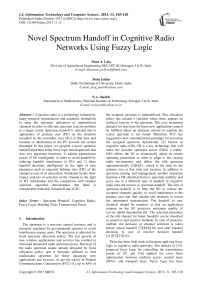Novel Spectrum Handoff in Cognitive Radio Networks Using Fuzzy Logic
Автор: Nisar A. Lala, Moin Uddin, N.A. Sheikh
Журнал: International Journal of Information Technology and Computer Science(IJITCS) @ijitcs
Статья в выпуске: 11 Vol. 5, 2013 года.
Бесплатный доступ
Cognitive radio is a technology initiated by many research organizations and academic institutions to raise the spectrum utilization of underutilized channels in order to alleviate spectrum scarcity problem to a larger extent. Spectrum handoff is initiated due to appearance of primary user (PU) on the channels occupied by the secondary user (SU) at that time and location or interference to the PU exceeds the certain threshold. In this paper, we propose a novel spectrum handoff algorithm using fuzzy logic based approach that does two important functions: 1) adjusts transmission power of SU intelligently in order to avoid handoff by reducing harmful interference to PUs and 2) takes handoff decisions intelligently in the light of new parameter such as expected holding time (HT) of the channel as one of its antecedent. Simulated results show impact analysis of selection of the channel in the light of HT information and the comparison with random selection algorithm demonstrates that there is considerable reduction in handoff rate of SU.
Spectrum Handoff, Cognitive Radio, Fuzzy Logic, Holding Time, Transmission Power
Короткий адрес: https://sciup.org/15011996
IDR: 15011996
Текст научной статьи Novel Spectrum Handoff in Cognitive Radio Networks Using Fuzzy Logic
Published Online October 2013 in MECS
The spectrum is a precious natural resource and is presently regulated by governmental agencies to avoid interference among users. The spectrum is allocated by fixed spectrum allocation policy. The fast growth of new wireless applications and services has resulted in increased demand of radio spectrum access. But most of the radio spectrum stands already allocated by fixed allocation policy and it becomes difficult to find unallocated spectrum for these upcoming new applications and services. As per the survey of Federal Communications Commission (FCC) [1], up to 85% of the assigned spectrum is underutilized. This allocation policy has created a situation where there appears an artificial scarcity of the spectrum. This ever increasing demand for spectrum for these new applications cannot be fulfilled unless an alternate scheme to regulate the scarce spectrum is not found. Therefore, FCC has suggested a new communication paradigm for accessing the assigned spectrum dynamically [2] known as cognitive radio (CR). CR is a key technology that will make the dynamic spectrum access (DSA) a reality. DSA allows the SU to dynamically adjust its certain operating parameters in order to adapt to the varying radio environment and utilize the idle spectrum opportunistically [3][4][5] , which is not used by the primary user at that time and location. In addition to spectrum sensing and management, another important function a CR should perform is spectrum mobility and gives rise to a different type of handoff in cognitive radio network known as spectrum handoff. The aim of spectrum handoff is to help the SU to release the occupied channels quickly to avoid interference to the primary user and find suitable idle channels to restart the interrupted transmission. The handoff to new channels should be seamless so that an application running on the SU perceives minimum quality of service (QoS) degradation [6] . The selection procedure of the idle channel for future handoffs can be classified as proactive and reactive methods. In case of proactive method, the decision of channel selection is taken before actual handoff [7][8][9][10] and after handoff decision, in case of reactive decision handoff [11][12][13][14].
There has been little work in literature applying fuzzy logic to cognitive radio networks. The authors of [15], proposed fuzzy logic for controlling the transmission power of SU and [16] applied for cross layer optimization between medium access control layer (MAC) and transport layer. Fuzzy logic has been proposed for controlling the spectrum access [17][18] and for spectrum handoff [19][20]. In this paper, we propose a novel spectrum handoff algorithm based on fuzzy logic. The works in [19][20] are most related to our work. Our work differs from previous works, that we propose to introduce expected holding time (HT) of the channel as one of the antecedent to fuzzy logic controller (FLC) in order to take handoff decision and we have used trapezoidal membership functions in place of triangular membership functions for the antecedents and the consequent. Our algorithm will take intelligent handoff decisions in the light of HT information (i.e. PU activity) of the channel and will select those channels for transmission of SU having largest HT parameter (or lowest PU activity).
The remainder of this paper is organized as follows: Section 2 provides the brief introduction to cognitive radio and expected holding time (HT) of the channel. Section 3 proposes the fuzzy logic based handoff algorithm. Section 4 presents the simulated results. Conclusion is provided in section 5.
-
II. Preliminaries2.1 Cognitive Radio
-
2.2 Expected Holding Time (HT) of the Channel
The main functions of the cognitive radio are [21]: Spectrum sensing: A cognitive user continuously monitors the wideband spectrum in order to find spectrum holes (or white spaces) and arrival of PU with the help of spectrum sensing techniques such as transmitter detection, interference based detection and cooperative detection. Each technique has its merits and demerits.
Spectrum management: Out of large number of idle channels, the SU has to select the best channels that will satisfy its QoS requirements. The spectrum management functions can be classified as spectrum analysis and spectrum decision.
Spectrum mobility: Due to appearance of the primary user on the channels occupied by the SU at that time, the SU has to change instantly its operating channels to other idle channels. The switching to these idle channels should be seamless so that there is minimum QoS degradation of the application running on the SU.
Spectrum sharing: After deciding the transmitting channel, the SU handshakes with its receiver and starts transmitting. A fair spectrum scheduling mechanism is to be devised for sharing of the spectrum with other SUs.
The licensed channels to be used opportunistically by the SUs depend on the activities of the PUs at a particular location and time in cognitive radio networks. In literature, licensed channel occupancy is modeled as
ON-OFF process. The ON represents the channel is used by PU at that time and OFF represents the channel is idle at that time. The wideband spectrum is sensed continuously to generate usage pattern statistics of all channels. Then average idle period known as expected holding time (HT) of every channel is calculated. HT is defined as the average time duration that the SU can utilize for its data transmission before PU reclaims the channel back. If HT is high, more time is available to the SU for its data transmission. To acquire knowledge about HT parameter, SU has to continuously sense the wideband spectrum which will put more computational burden on SU and also increases its power consumption. We assume in this paper, that HT data is available either provided by spectrum server [22] or SU has the capability to compute HT parameter. By incorporating the HT information (i.e., PU activity) into the decision making, its impact on handoff probability is analyzed using fuzzy logic based approach.
-
III. Proposed Fuzzy Logic based Handoff Algorithm
-
3.1 Fuzzy Logic Controller (FLC1) for Power Control
The proposed scheme is implemented by means of hierarchical fuzzy logic controller (FLC) as shown in Fig. 1. The 1st FLC estimates the optimal transmission power of SU in order to control harmful interference to PUs and hence, avoids unnecessary handoff. The 2nd FLC takes intelligent handoff decision based on information of transmit power of SU (SUpower), required data rate (SUdatarate) and expected holding time (HT) information based on PU activity of the channel. In this case, handoff is initiated if the selected power of SU is not enough to sustain the QoS (i.e. data rate) of the SU and interference to PU is high. Our algorithm can operate both in overlay and underlay mode by intelligently controlling the transmission power of SU. The undesired spectrum handoff can be avoided by controlling the transmission power and by selecting the channels having largest holding time (i.e. lowest PU activity) among the available idle channels to achieve a considerable reduction in handoff rate.
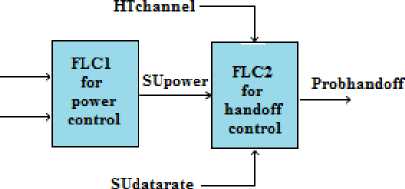
Fig. 1: Hierarchical fuzzy logic system
After a specific time interval, the SU measures the power of the PU at SU (Rpower) and estimates the actual transmission power of the PU (Tpower). It is assumed that SU has the capability to estimate the Tpower. Then comparison is made between Rpower and Tpower in order to take a decision on the optimal transmission power of SU (SUpower). The two antecedents (or inputs) used for FLC1 to determine the SUpower are:
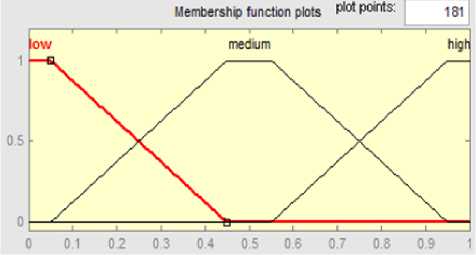
Rpower and Tpower
Fig. 2: Membership functions used for Antecedent 1 (Rpower) and Antecedent 2 (Tpower)
Antecedent 1: Rpower i.e. power received by SU from PU (dBm).
Antecedent 2: Tpower i.e. actual transmission power of PU (dBm). and the consequent is optimal transmission power of SU (SUpower) (dBm).
The two antecedents and the consequent are characterized by a term set ‘T(x)’ of three fuzzy sets each such as low, medium and high, as shown in (1), defined over a specific universe of discourse
T(Rpower) = T(Tpower) = T(SUpower)
= {low, medium, high} (1)
We have used trapezoidal membership functions for two antecedents (Rpower, Tpower) and the consequent (SUpower) as shown in Fig. 2 and Fig. 3.
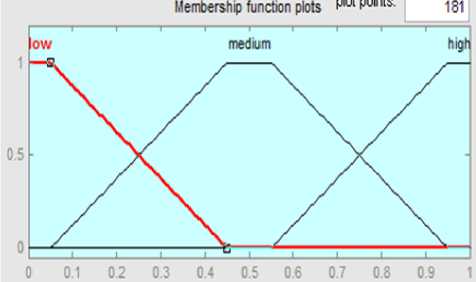
SUpower
Fig. 3: Membership function used for the consequent (SUpower)
The analysis of the algorithm has been performed over normalized values of the antecedents and the consequent between [0, 1]. Table 1 show the rules contained in the rule base of FLC1. Fuzzy nine IF-
THEN rules were designed to help the fuzzy inference engine to take decisions. The logic behind their definition is to realize optimal transmission power of the SU. For example, as per rule 3, if the Rpower is low and Tpower is high then the SUpower is high, this corresponds to the situation of very low interference in the communication channel and therefore, allocates the maximum admissible transmission power to the SU. Also as per rule 9, when the Rpower and Tpower is high then SUpower is low, this corresponds to the situation of high interference in the communication channel. Therefore, the transmitted power is reduced and allocation of power is minimum in order to avoid harmful interference to PU.
Table 1: Rule base of FLC1 for transmission power control
|
Rule # |
Rpower |
Tpower |
SUpower |
|
1 |
Low |
Low |
Low |
|
2 |
Low |
Medium |
Medium |
|
3 |
Low |
High |
High |
|
4 |
Medium |
Low |
Low |
|
5 |
Medium |
Medium |
Low |
|
6 |
Medium |
High |
Medium |
|
7 |
High |
Low |
Low |
|
8 |
High |
Medium |
Low |
|
9 |
High |
High |
Low |
-
3.2 Fuzzy Logic Controller (FLC2) for Handoff Decision
This FLC is in charge of taking the handoff decisions based on three descriptors (antecedents) such as transmit power (SUpower), required data rate i.e. QoS (SUdatarate) and HT information (HTchannel) of the channel. The three antecedents and one consequent are:
Antecedent 1: HT information of the channel (HTchannel) (seconds).
Antecedent 2: required data rate (SUdatarate) (bps).
Antecedent 3: transmission power of SU (SUpower) (dBm). and the consequent is handoff probability (probhandoff).
The three antecedents are characterized by a term set ‘T(x)’ of three fuzzy sets each such as low, medium and high, as shown in (2), defined over a specific universe of discourse
T(HTchannel) = T(SUdatarate) = T(SUpower)
= {low, medium, high} (2)
And the consequent is characterized by a term set ‘T(x)’ of four fuzzy sets such as No, Probably No, Probably Yes and Yes, as shown in (3), defined over a specific universe of discourse
T(Probhandoff) = {No, PNo, PYes, Yes} (3)
We have used trapezoidal membership functions for three antecedents and the consequent are shown in Fig. 4 and Fig. 5. The analysis of the algorithm has been performed over normalized values of the antecedents and the consequent between [0, 1]. Table 2 show the rules contained in the rule base of FLC2. Fuzzy 27 IF-THEN rules were designed to help the fuzzy inference engine to take handoff decisions. The logic behind their definition is to take the ideal handoff decision. For example, as per rules 7, 8 and 9, the algorithm take the decision of not to handoff and as per rules 22, 23 and 24, the algorithm take the decision of handoff to other idle channels.
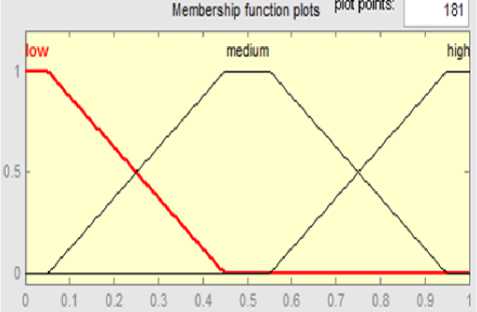
HTchannel, SUpower and SUdatarate
Fig. 4: Membership functions used for three inputs of FLC2 i.e.
Antecedent 1 (HTchannel), Antecedent 2 (Supower) and Antecedent 3 (SUdatarate)
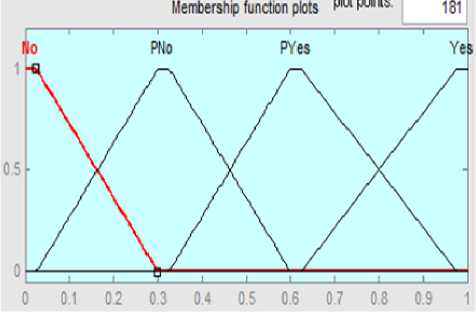
Consequent (Probhandoff)
Fig. 5: Membership function used for consequent of FLC2 i.e. Probhandoff
Table 2: Rule base of FLC2 for spectrum handoff decision
|
Rule # |
HTchannel |
SUpower |
SUdatarate |
Probhandoff |
|
1 |
high |
low |
low |
PYes |
|
2 |
high |
low |
medium |
Yes |
|
3 |
high |
low |
high |
Yes |
|
4 |
high |
medium |
low |
No |
|
5 |
high |
medium |
medium |
No |
|
6 |
high |
medium |
high |
PNo |
|
7 |
high |
high |
low |
No |
|
8 |
high |
high |
medium |
No |
|
9 |
high |
high |
high |
No |
|
10 |
medium |
low |
low |
Yes |
|
11 |
medium |
low |
medium |
Yes |
|
12 |
medium |
low |
high |
Yes |
|
13 |
medium |
medium |
low |
No |
|
14 |
medium |
medium |
medium |
PNo |
|
15 |
medium |
medium |
high |
PYes |
|
16 |
medium |
high |
low |
No |
|
17 |
medium |
high |
medium |
No |
|
18 |
medium |
high |
high |
PNo |
|
19 |
low |
low |
low |
Yes |
|
20 |
low |
low |
medium |
Yes |
|
21 |
low |
low |
high |
Yes |
|
22 |
low |
medium |
low |
Yes |
|
23 |
low |
medium |
medium |
Yes |
|
24 |
low |
medium |
high |
Yes |
|
25 |
low |
high |
low |
PYes |
|
26 |
low |
high |
medium |
PYes |
|
27 |
low |
high |
high |
PYes |
-
IV. Simulated Results
-
4.1 Simulation Results For FLC1
The proposed algorithm has been simulated in fuzzy logic toolbox of Matlab 7.6.
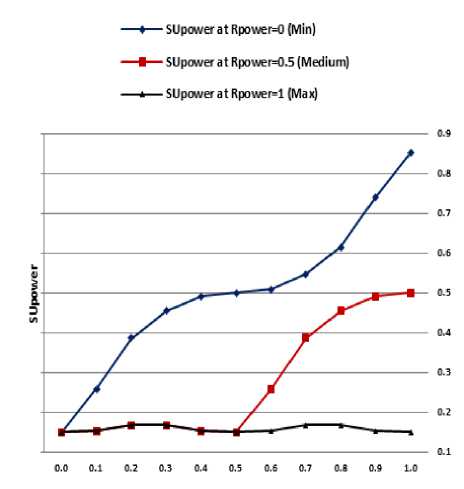
Tpower
Fig. 6: Simulation results show impact of Tpower on SUpower at constant three values (i.e. min., medium and max.) values of Rpower
Here, we simulate the SUpower as a function of Rpower and Tpower. Fig. 6 shows the impact of Tpower, at three different constant values of Rpower, on SUpower while Fig. 7 shows impact of Rpower, at three different constant values of Tpower, on SUpower.
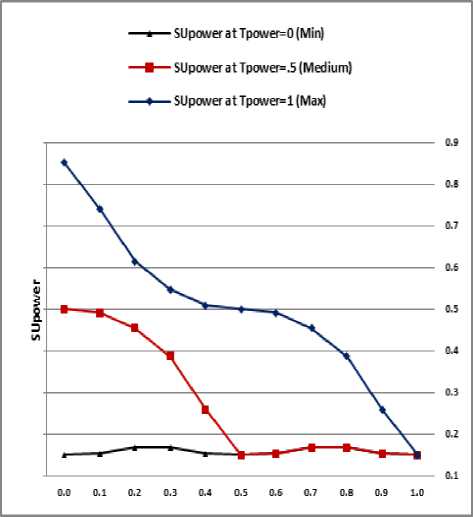
Rpower
Fig. 7: Simulation results show impact of Rpower on SUpower at three constant (i.e. min., medium and max.) values of Tpower
The results show that SUpower remains at minimum value when Rpower ≥ Tpower and there has been linear increase in SUpower when Tpower > Rpower. As can be seen from Fig. 8, the maximum value of SUpower is attained when Rpower is at minimum value and Tpower is at maximum value. Our algorithm helps SU to change the transmission power gradually in order to adapt to the dynamic channel condition.
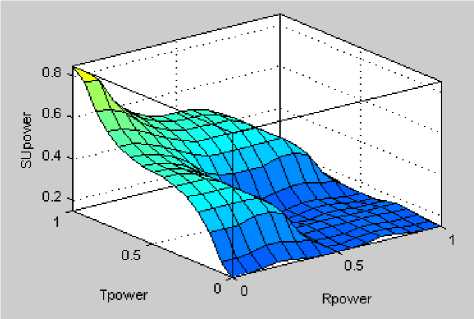
Fig. 8: Simulation results show simutaneous impact of Rpower and Tpower on SUpower
-
4.2 Simulation Results for FLC2
This fuzzy logic system is in charge of taking handoff decision. When Probhandoff ≥ 0.5, the algorithm takes the decision of spectrum handoff, therefore, switches to other idle channels. Fig. 9, Fig. 10 and Fig. 11 show the impact of HTchannel, SUdatarate and SUpower on the handoff probability.
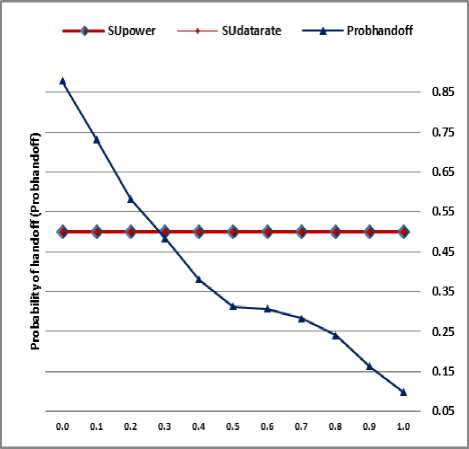
HTchannel
Fig. 9: Simulation results show impact of HTchannel on Probhandoff at constant values of SUpower, SUdatarate=0.5 (medium)
As can be seen from Fig. 9 that with increase in HTchannel, at constant values of SUpower and SUdatarate, the probability of handoff decreases. The proposed algorithm helps in selection of channel having largest HT value (i.e. idle period), which results in higher throughput and lesser number of handoff.
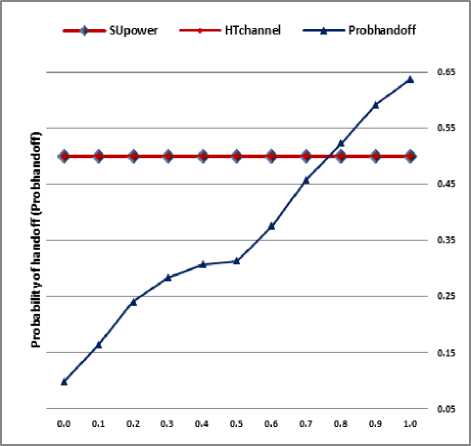
SUdatarate
Fig. 10: Simulation results show impact of SUdatarate on Probhandoff at constant values of SUpower, HTchannel=0.5 (medium)
As can be seen from Fig. 10 that with increase in SUdatarate, at constant values of SUpower and HTchannel, the probability of handoff increases.
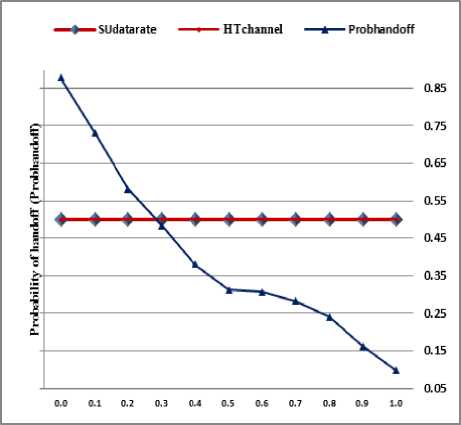
Supower
Fig. 11: Simulation results show impact of SUpower on Probhandoff at constant values of SUdatarate, HTchannel=0.5 (medium)
As can be seen from Fig. 11 that with increase in SUpower, at constant values of SUdatarate and HTchannel, the probability of handoff decreases. By adjusting the SUpower, the harmful interference to PU can be mitigated that reduces the necessity of handoff and hence results in reduction of number of handoffs.
Fig. 12 shows simultaneous impact of SUpower and HTchannel, at constant value of SUdatarate, on the probability of handoff. It can be seen that probability of handoff decreases with increase in HTchannel and SUpower and obtains a minimum value when HTchannel and SUpower are both at maximum values.
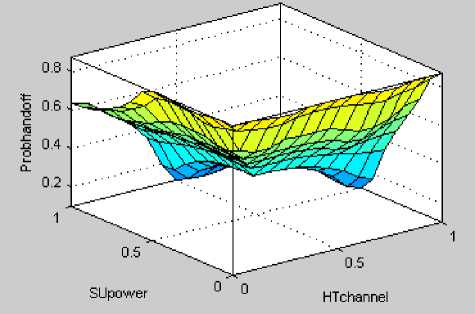
Fig. 12: Simulation results show impact of SUpower and HTchannel on Probhandoff at constant value of SUdatarate=0.5 (medium)
Fig. 13 shows simultaneous impact of SUdatarate and HTchannel, at constant value of SUpower, on the probability of handoff. It can be seen that handoff probability decreases with increase in HTchannel and decrease in SUdatarate and obtains a minimum value when HTchannel is at maximum value and SUdatarate is at minimum value.
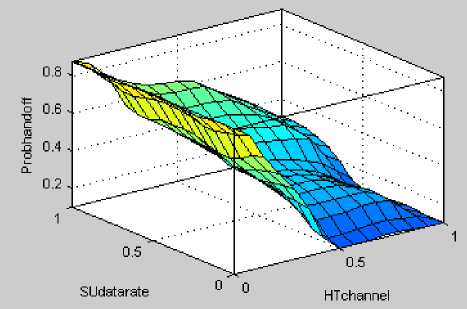
Fig. 13: Simulation results show impact of SUdatarate and HTchannel on Probhandoff at constant value of SUpower=0.5 (medium)
Fig. 14 shows the impact of SUpower and SUdatarate, at constant value of HTchannel, on the probability of handoff. It can be seen that handoff probability decreases with increase in SUpower and decrease in SUdatarate and obtains a minimum value when SUpower is at maximum value and SUdatarate is at minimum value.
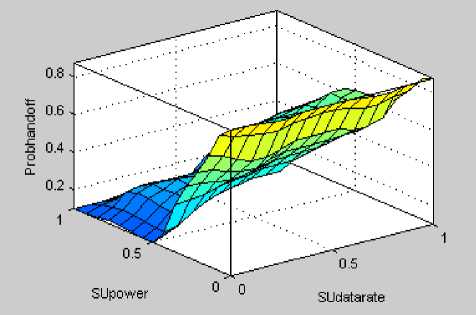
Fig. 14: Simulation results show impact of SUpower and SUdatarate on Probhandoff at constant value of HTchannel=0.5 (medium)
-
4.3 Comparison of Proposed Algorithm with Random Selection Algorithm (i.e. Without HT Information)
In this simulation, we have compared two algorithms as a function of deviation from largest HT value. As can be seen from Fig. 15, the handoff probability of the proposed algorithm remains constant and always selects the channel having largest HT value. In case of random selection, the handoff probability increases with increase in deviation from largest HT value as the average idle period of channel decrease with increase in deviation from largest HT value. Therefore, for same service time requirement of SUs, the random selection algorithm experiences necessity of earlier handoff due to shorter idle period of the selected channels which result in higher number of handoffs. Therefore, the proposed algorithm experiences lesser number of handoffs due to selection of channels having largest HT value (i.e. average idle period). As a result, there is considerable reduction in handoff rate of the proposed algorithm.
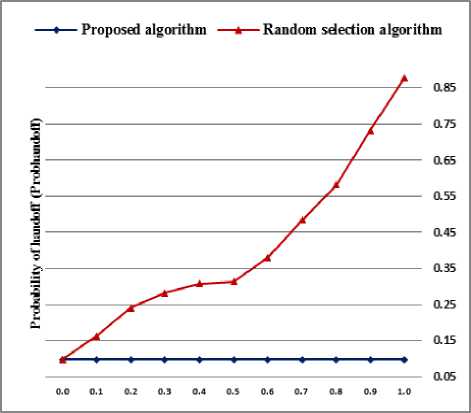
Deviation from largest HT value
Fig. 15: Comparison of proposed algorithm and random selection algorithm
-
V. Conclusion
In this paper, we have proposed a novel spectrum handoff algorithm using fuzzy logic approach for cognitive radio networks. The algorithm selects the optimal transmission power for SU in order to avoid interference to PU and takes handoff decision based on knowledge of transmission power, data rate and HT (i.e. average idle period) of a channel. The proposed algorithm helps in selection of the channel having largest HT value, which results in achieving higher quality of service (QoS) for the application running on the SU. Hence, the proposed algorithm reduces the number of required handoffs. The simulated results validate the findings.
Список литературы Novel Spectrum Handoff in Cognitive Radio Networks Using Fuzzy Logic
- FCC. Notice of proposed rulemaking and order No. 03-222. Dec. 2003.
- Et docket No.03-237, Nov. 2003. [Online] Available: http://hraunfoss.fcc.gov/edocs_public/attachmatch/ FCC-03-289A1.pdf.
- Mitola J. Cognitive radio: an integrated agent architecture for software defined radio. Ph. D. Dissertation: KTH Royal Institute of Technology, 2000.
- Mitola J, Maguire GQ. Cognitive radio: making software radios more personal [J]. IEEE Personal Communications, 1999, 6(4):13-18.
- Haykin S. Cognitive radio: Brain empowered wireless communications [J]. IEEE Journal on Selected Areas in Communications, 2005, 23(2): 201-220.
- Liu HJ, Wang ZX, Ll SF, Yl M. Study on the performance of spectrum mobility in cognitive wireless network [C]. In: Proceedings of (IEEE) International Conference on Communication Systems (ICCS), 2008.
- Song Y, Xie J. Proactive spectrum handoff in cognitive radio adhoc networks based on common hopping coordination [C]. In: Proceedings of (IEEE) INFOCOM, 2010.
- Zheng S, Yang X, Chen S, Lou C. Target channel sequence selection scheme for proactive- decision spectrum handoff [J]. IEEE Communication Letters, 2011, 15(12):1332-1334.
- Song Y, Xie J. ProSpect: A proactive spectrum handoff framework for cognitive radio adhoc networks without common control channel [J]. IEEE Transactions on Mobile Computing, 2012, 11(7):1127-1139.
- Wang C-W, Wang L-C. Modeling and analysis for proactive decision spectrum handoff in cognitive radio networks [C]. In: Proceedings of (IEEE) International Conference on Communications (ICC), 2009.
- Willkomm D, Gross J, Wolisz A. Reliable link maintenance in cognitive radio systems [C]. In: Proceedings of (IEEE) International Symposium on Dynamic Spectrum Access Networks (DySPAN), 2005.
- Tian J, Bi G. A new link maintenance and compensation model for cognitive UWB radio systems [C]. In: Proceedings of International Conference on ITS Telecommunications, 2006.
- Wang L-C, Wang C-W. Spectrum handoff for cognitive radio networks: reactive sensing or proactive sensing [C]. In: Proceedings of (IEEE) International Performance Computing and Communications Conference (IPCCC), 2008.
- Wang C-W, Wang L-C, Adachi F. Modeling and analysis for reactive decision spectrum handoff in cognitive radio networks[C]. In: Proceedings of (IEEE) GLOBECOM, 2010.
- Le H-S T, Liang Q. An efficient power control scheme for cognitive radios [C]. In: Proceedings of Wireless Communications and Networks Conference, 2007:2559-2563.
- Baldo N, Zorzi M. Fuzzy logic for cross layer optimization in cognitive radio networks [J]. IEEE Communication Magazine, 2008:64-72.
- Le H-S T, Ly HD. Opportunistic spectrum access using fuzzy logic for cognitive radio networks [C]. In: Proceedings of 2nd International Conference on Communications and Electronics (ICCE), 2008: 240- 245.
- Kaur P, Moin Uddin, Khosla A. Fuzzy based adaptive bandwidth allocation scheme in cognitive radio networks [C]. In: Proceedings of International Conference on ICT and knowledge Engineering, 2010: 41-45.
- Giupponi L, Perez-Neira AI. Fuzzy based spectrum handoff in cognitive radio networks [C]. In: Proceedings of 3rd International Conference on Cognitive Radio Oriented Wireless Networks and and Communications CrownCom 2008: 1-6.
- Kaur P, Moin Uddin, Khosla A. An efficient spectrum mobility management strategy in cognitive radio networks. 1st UK-India International Workshop on Cognitive Wireless Systems UKIWCWS, 2009.
- Akyildiz IF, Lee WY, Vuran MC, Mohanty S. Next generation/dynamic spectrum access/cognitive radio wireless networks: A survey [J]. Computer Networks (Elsevier), 2006, 50: 2127–2159.
- Dahi S, Tabbane S. Radio resource management on the basis of temporal characterization of spectrum holes in cognitive radio networks [C]. In: Proceedings of 14th International Symposium on Wireless Personal Multimedia Communication (WPMC), 2011.

